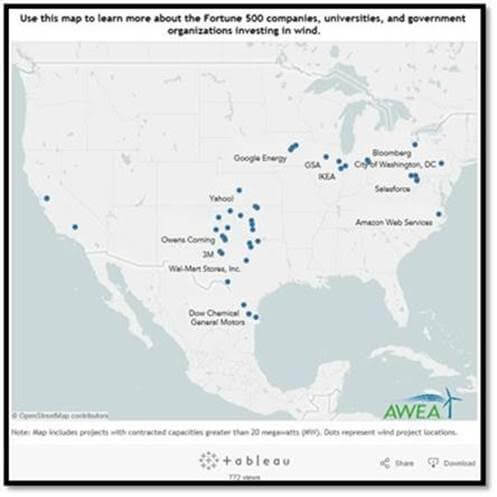Major brands and other emerging non-utility customers signed 52%, or 2,074 MW, of the wind-power capacity contracted through power purchase agreements (PPA) in 2015. Customers driving this new demand for wind energy include Fortune 500 companies behind household brands, like Tide and Downy, high-tech companies, universities, and major U.S. cities.
This non-traditional customer class contracted for the majority of electric generating capacity though wind PPAs in a given year for the first time, according to the American Wind Energy Association’s (AWEA) forthcoming 2015 U.S. Wind Industry Annual Market Report, set for release on April 12 in Denver, Colorado.

“Every time Americans use the Internet or do laundry, it’s more likely that wind energy made it possible,” said Tom Kiernan, CEO of AWEA. “Innovation has driven down the price, resulting in phenomenal growth in demand for wind energy from corporate buyers, in large part because it saves them money. Signing a long-term wind contract provides these buyers with a package of benefits—low-cost, fixed-price, clean energy—that’s easy to say “yes” to.”
With the price of wind energy two-thirds cheaper than it was in 2009, wind power has become one of the lowest cost sources of energy in certain regions of the country, according to Lawrence Berkeley National Laboratory, and that has increasing appeal to organizations with goals both to lower emissions, and to secure low-cost, fixed-price energy that protects them from fuel price fluctuations.
Demand from corporate buyers and other emerging wind-energy customers is growing exponentially. Traditionally, utilities buy the largest amount of wind energy overall; rising demand from Fortune 500 companies and others represents an additional, expanded market. The 52% share of capacity contracted for by non-utility purchasers in 2015 more than doubles the 23% share of that market contracted for in 2014, and far outpaces the 5% share in 2013.
In total, corporate and other emerging buyers have signed contracts for more than 4,500 MW of wind-power capacity, enough to power the equivalent of over 1.2 million average American homes.
Corporate buyers who signed PPAs in 2015 include large brick-and-mortar operations such as Walmart and Dow Chemical, as well as hi-tech firms such as Google Energy, Amazon Web Services, and Salesforce. They join a growing list of cities – including Washington, D.C. – and academic institutions, such as Cornell University and Oklahoma State University, which have signed wind energy PPAs. In all, over 70 organizations make up this class of emerging customers that have invested in specific wind projects either through long-term contracts or direct ownership.

Click here to view an interactive map of the wind projects powering Fortune 500 companies, universities and American cities.
“Today’s leading companies understand that a long-term purchase of wind energy can help them lower costs and improve the environmental performance of their operations and those that have not already executed deals are working aggressively to identify and understand their purchasing options,” said Charles Esdaile, Managing Partner at Altenex, a third-party buyer’s agent that helps customers procure renewable energy. “We have seen the market grow dramatically over the past four years and we expect this trend to continue as long as the market continues to support the needs of corporate buyers by delivering high-quality, cost-effective products.”
There is substantial room for growth in this sector. Last year, big brands and other non-utility customers announced PPAs for wind projects located in one quarter of the 40 states that currently host large-scale wind farms. States with pro-wind energy policies, and that are part of wholesale electricity markets, offer large electricity consumers the most opportunity to procure wind energy. These procurements boost economic development by attracting new facilities like data centers and the wind farms to serve them. Such facilities in turn bring jobs and tax revenue to rural communities.
While leading companies and other organizations are interested in low-cost, fixed-price energy, many also seek to limit their environmental and public health impact. Just one new wind turbine can avoid over 4,200 metric tons of carbon dioxide (CO2) annually, the equivalent of nearly 900 cars’ worth of emissions. By displacing the use of fossil fuels, these purchases of wind energy directly reduce air-pollution emitted by the electric power sector.
Corporate customers have multiple options for investing in wind power. While one option is direct ownership, either on-site or off-site, the most popular option remains to procure wind energy through a PPA, allowing purchasers to lock in low prices over a long time horizon, similar to a fixed-rate mortgage. A PPA is structured so that a buyer can purchase the electricity output from a wind farm at a fixed price over a period of time, typically 10 to 20 years, while a third party owns and operates the turbines. This lets the customer purchase wind energy and get its benefits without requiring the expertise to develop and operate a wind farm.
Corporate and other non-utility buyers are the most rapidly growing customer class for wind energy, but demand remains strong among traditional utility buyers for many of the same reasons. Wind energy is one of the biggest, fastest and cheapest ways for states and utilities to cut carbon pollution. States seeking to get ahead of carbon regulations like the EPA’s Clean Power Plan can create jobs and save all consumers money meanwhile by adding wind power.
AWEA’s 2015 U.S. Wind Industry Annual Market Report will be released near Vestas Wind Systems’ Brighton Nacelle manufacturing facility outside Denver on April 12.
Colorado Gov. John Hickenlooper will join wind industry leaders in releasing the annual report. It contains detailed information on the trend of big brands and other emerging buyers of wind energy, as well as the latest nationwide jobs and manufacturing data and more.
AWEA
www.awea.org
Filed Under: News, Policy




